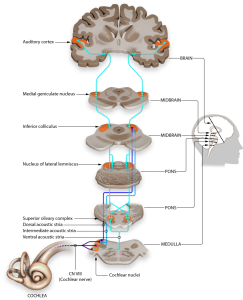Module 12: Nonvisual Senses

Description: This module explores sensory systems beyond vision, including audition (hearing), somatosensation (touch, pain, temperature), vestibular function (balance), & chemical senses (taste & smell). Students will examine how these systems detect & transduce stimuli, how sensory information is processed in the brain, & how sensory disorders affect perception & behavior. The module also highlights cultural influences on perception & emerging interventions like stem cell therapy.

Why This Module is Important: Nonvisual senses are essential for communication, survival, & emotional connection. Understanding these systems is critical for psychology professionals working in clinical, counseling, educational, & research settings.
For counselors, this module provides:
- Insight into sensory disorders & their psychological impact.
- Understanding of how sensory loss affects identity, emotion, & social connection.
- Tools for discussing sensory restoration & assistive technologies with clients.
For other psychology professionals, this module supports:
- Research into sensory processing & neuroplasticity.
- Educational strategies for students with sensory impairments.
- Clinical assessment of pain, balance, & sensory integration issues.
- Application of neuroscience to therapies involving sensory stimulation.
Module Learning Objectives: By the end of this module students will be able to…
- MLO1: Describe the anatomy & physiology of auditory, somatosensory, vestibular, & chemical sensory systems. (CLO1, ULO2)
- MLO2: Analyze how sensory stimuli are transduced & processed in the brain, including mechanisms of perception & localization. (CLO2, CLO3, ULO2)
- MLO3: Evaluate sensory disorders & emerging interventions, including stem cell therapy & cultural influences on perception. (CLO3, CLO4, ULO2)
Test Yourself: If you truly “know” this material then you will be able to…
- Explain how sound waves are transduced into neural signals by the cochlea & interpreted by auditory cortex. (MLO1)
- Compare the effects of infrasound & ultrasound on human physiology & perception, including psychological responses. (MLO2)
- Evaluate the potential of stem cell therapy for sensory restoration & discuss ethical & clinical implications. (MLO3)
Media Attributions
- Smellin’ Buddy © Microsoft Copilot adapted by Jay C. Brown is licensed under a CC0 (Creative Commons Zero) license
- A Lady at the Virginals with a Gentleman © Johannes Vermeer is licensed under a Public Domain license
- Auditory Pathway © Jonathan Peele is licensed under a CC BY (Attribution) license
